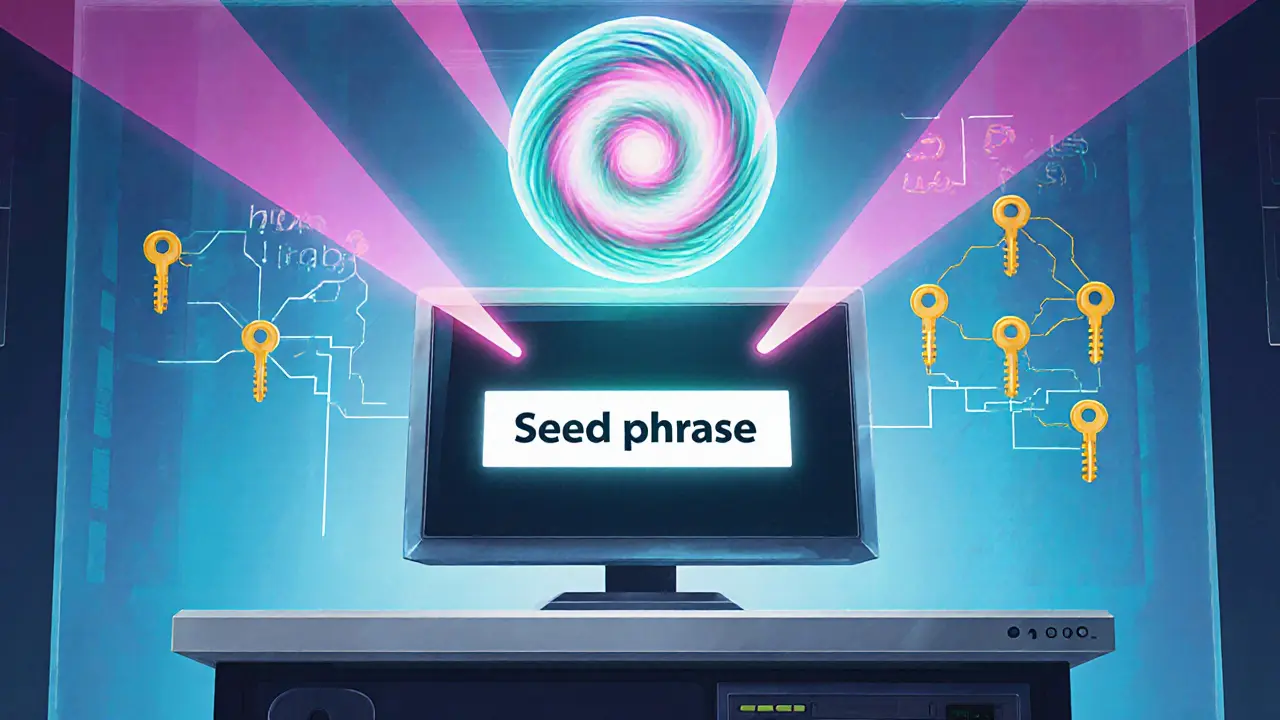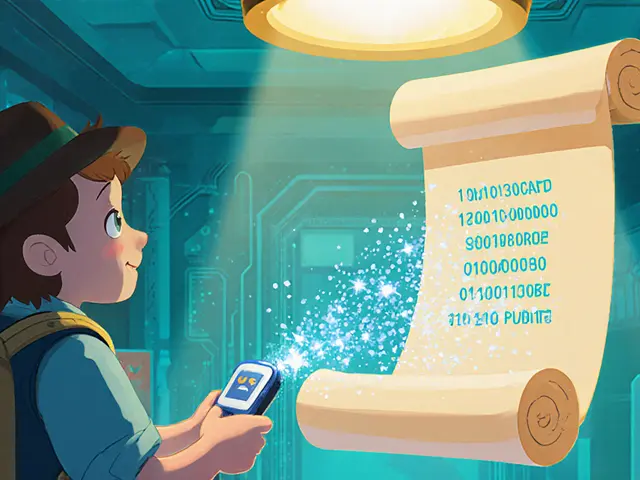Seed Phrase Security Calculator
Seed Phrase Analysis
Security Summary
Ever wondered how a simple list of twelve or twenty‑four words can unlock thousands of crypto addresses? That list, called a seed phrase, is the backbone of modern wallets. In this guide we’ll walk through the exact steps - from random numbers to the private keys that actually sign transactions - so you can see why protecting that phrase matters more than any single key.
What a Seed Phrase Actually Is
Seed phrase is a human‑readable representation of a cryptographic seed used to rebuild a wallet. It typically consists of 12 or 24 words drawn from a standardized list of 2048 English words defined by BIP‑39. Because the words are easy to write down, users can store them offline without needing to memorize a 256‑bit number.
Generating the Words: Entropy, Checksum, and Wordlist Mapping
The journey begins with cryptographic entropy. A wallet’s RNG creates 128‑bits (for 12 words) or 256‑bits (for 24 words) of pure randomness. This raw entropy alone isn’t enough - a checksum is added to catch transcription errors. The checksum is derived by hashing the entropy with SHA‑256 and taking the first 4 or 8 bits, depending on length. The combined bit string is split into 11‑bit chunks, each indexing one of the 2048 words in the BIP‑39 list.
From Words to a 512‑Bit Seed: PBKDF2 and HMAC‑SHA512
When you type the phrase back into a wallet, the software runs the PBKDF2 key‑derivation function. PBKDF2 takes the phrase as the password and the string "mnemonic" plus an optional user‑chosen passphrase as the salt. It then performs 2048 iterations of HMAC‑SHA512 to produce a 512‑bit seed. This seed is the master secret from which all private keys are deterministically derived.
Deriving Private Keys: BIP‑32, BIP‑44, and HD Wallets
The 512‑bit master seed feeds into BIP‑32, the hierarchical deterministic (HD) wallet standard. BIP‑32 defines a tree structure where each node is a private key paired with a public key. From the master node, you can derive any number of child keys by applying HMAC‑SHA512 again, using a specific derivation path. For most multi‑currency wallets, BIP‑44 refines the path (m/44'/coin_type'/account'/change/address_index) so that Bitcoin, Ethereum, and others each get their own logical branch.

Why Private Keys Are Not Stored Directly
A private key is a 256‑bit number, usually shown as a 64‑character hex string. It controls a single address. Storing thousands of such keys would be a nightmare for users. The seed phrase solves that by letting the wallet regenerate any private key on demand, as long as the same seed and the same derivation path are used. That’s why you can restore an entire portfolio-including Bitcoin, Ethereum, and dozens of tokens-just from the phrase.
Security Strength: Bits of Entropy and Real‑World Numbers
A 12‑word seed gives you 128 bits of security, even though there are 2^132 possible word combinations (the extra 4 bits are the checksum). That matches the security of a raw 256‑bit private key because the seed is fed through SHA‑512 and HMAC‑SHA512, which are collision‑resistant. A 24‑word phrase pushes security to 256 bits, effectively the same as the maximum strength of SHA‑256. In practice, breaking either a seed phrase or a private key by brute force is infeasible with today’s computing power.
Practical Backup: From Paper to Metal
Because the seed phrase is the single point of recovery, best‑practice backup is critical. Experts recommend writing the words on acid‑free paper or, better yet, engraving them onto stainless‑steel plates that survive fire, water, and magnetic fields. Store multiple copies in geographically separate locations-at least 5 miles apart per NIST guidelines. Never photograph or store the phrase digitally; studies show that 62% of compromises happen through cloud leaks or screenshots.
Common Pitfalls and Human Errors
Even a tiny typo can render a phrase useless. The BIP‑39 list is designed so the first four letters of each word are unique, providing error detection, but missing a word or swapping order still breaks the checksum. Real‑world stories abound: a Reddit user once lost $12,000 by writing down only eleven words. Another frequent mistake is using a personally generated phrase instead of the wallet’s RNG-human‑generated entropy dramatically reduces security.

Compatibility Across Wallets and Chains
Any wallet that follows BIP‑39, BIP‑32, and BIP‑44 will interpret the same seed phrase identically. That means you can import your phrase into hardware wallets like Ledger or Trezor, software wallets like MetaMask, or mobile apps like Trust Wallet and recover the exact same set of private keys. However, some wallets use custom derivation paths for specific tokens, so always double‑check the path if you’re moving across ecosystems.
Future Directions: BIP‑85 and Shamir Secret Sharing
Developers are extending the seed phrase concept. BIP‑85 lets you deterministically generate multiple independent seed phrases from a single master seed, enabling separate backups for different purposes without extra paper. Meanwhile, Shamir Secret Sharing splits a phrase into several shards (e.g., 3‑of‑5) so that no single piece reveals the whole seed. By 2026, analysts predict that most new wallets will adopt such threshold schemes to mitigate the single‑point‑of‑failure risk.
Quick Comparison: Seed Phrase vs Private Key
| Aspect | Seed Phrase | Private Key |
|---|---|---|
| Format | 12‑ or 24‑word mnemonic | 64‑character hex string |
| Security bits | 128bits (12 words) / 256bits (24 words) | 256bits |
| Number of keys generated | Potentially infinite (hierarchical) | One per private key |
| Human readability | High - easy to write down | Low - raw binary data |
| Backup method | Paper, metal plates, Shamir shards | Usually not backed up directly |
Bottom Line: Protect the Phrase, Protect the Wallet
In short, the seed phrase is the wallet. It turns random entropy into a reproducible seed, which then spawns every private key you’ll ever use. Guard it like a gold bar: keep it offline, store it in multiple safe places, and never share it. If you keep the phrase safe, the private keys stay safe by definition.
Frequently Asked Questions
Can I use the same seed phrase on different wallets?
Yes. Any wallet that follows BIP‑39/BIP‑32 will generate identical private keys from the same phrase, as long as the derivation path is the same. Just make sure the new wallet supports the same coin type (e.g., Bitcoin uses coin_type0, Ethereum uses 60).
What happens if I lose one word of my 12‑word phrase?
The checksum will fail, and the wallet will reject the phrase. You’ll need to recover the missing word from a backup or start a new wallet.
Is a hardware wallet safer than a paper backup?
Hardware wallets protect the private keys during use, but they still require a seed phrase backup for recovery. The safest approach is to combine a hardware wallet with a metal‑engraved seed phrase stored in separate locations.
Can I add a passphrase to strengthen my seed phrase?
Yes. Adding a user‑chosen passphrase (sometimes called a "13th word") is hashed together with the mnemonic, creating a completely different seed. Keep the passphrase secret and backed up separately.
What is BIP‑85 and why should I care?
BIP‑85 lets you derive multiple independent seed phrases from a single master seed. It’s handy for creating separate recovery phrases for different projects without having to write down new words each time.


Comments
Hey folks, if you’re just getting started with seed phrases, think of them as the master key to an entire vault of crypto. The BIP‑39 list of 2048 words makes it readable, but each word hides a chunk of raw entropy. That entropy is what fuels the 128‑bit or 256‑bit security you hear about. Never write your phrase on a phone screenshot – write it down on paper or metal instead. And always double‑check the order; swapping two words ruins the checksum instantly.
Keep it offline and away from strangers.
The seed phrase is essentially a human‑friendly representation of a cryptographic seed.
The moment your wallet generates 128 bits of entropy, it appends a 4‑bit checksum derived from SHA‑256.
This combined 132‑bit string is sliced into eleven‑bit segments that index the BIP‑39 wordlist.
Each of those 11‑bit pieces points to one of the 2048 allowed words, giving you the familiar twelve‑word mnemonic.
The same process works for a 24‑word phrase, only with 256 bits of entropy and an 8‑bit checksum.
Because the checksum is built from the original entropy, any typo or missing word will cause the checksum validation to fail.
That failure is actually a built‑in safety net, preventing you from entering a near‑correct but wrong phrase.
After you type the phrase back into a wallet, the software runs PBKDF2 with 2048 iterations of HMAC‑SHA‑512.
The resulting 512‑bit seed becomes the master secret for the entire hierarchical deterministic (HD) tree.
From that master seed, BIP‑32 derives child private keys using hardened or non‑hardened derivation paths.
The standard BIP‑44 path m/44'/coin_type'/account'/change/address_index separates different coins and accounts.
This means a single twelve‑word phrase can recreate every Bitcoin, Ethereum, and countless other addresses you ever used.
The security of those derived keys is no weaker than the original seed because the key‑stretching functions are cryptographically strong.
In practice, brute‑forcing a twelve‑word phrase would require trying 2^128 possibilities, which is astronomically infeasible with current hardware.
So protecting that short list of words is literally protecting the entire universe of your crypto holdings.
Listen, the math behind BIP‑39 isn’t optional – it’s the foundation of every secure wallet on the planet. A twelve‑word phrase gives you exactly 128 bits of entropy, no more, no less. Anything less than that and you’re exposing yourself to a trivial attack surface. Double‑check every word, every space, before you ever hit “import”.
One must recognize that the elegance of a mnemonic belies its responsibility. A careless jot on a post‑it is a betrayal of cryptographic principle.
Consider the seed phrase as a philosophical anchor; it ties the intangible notion of digital wealth to a concrete utterance. In a world where value is often abstract, this handful of words grants agency. Yet that agency is fragile, susceptible to the slip of a single syllable. The checksum serves as a modest reminder that our intentions must be precise. When you lose a word, the entire edifice collapses, echoing the impermanence of material possessions. Therefore, safeguarding the phrase is a meditative practice as much as a security measure. Embrace the discipline.
It is advisable to store the mnemonic in a fire‑proof container and to keep multiple copies in geographically diverse locations. Such redundancy mitigates the risk of natural disasters. Moreover, never disclose the phrase to any online service, regardless of apparent legitimacy.
From an analytical standpoint, the entropy calculation is straightforward: 12 words → 128 bits, 24 words → 256 bits. The inclusion of the checksum adds a layer of error detection that is often overlooked by novices. When evaluating a wallet’s security, always verify that it adheres to BIP‑39, BIP‑32, and BIP‑44 standards. Failure to do so can expose the seed to subtle implementation bugs.
Looks solid but keep it simple, don’t overthink.
One practical tip: before you ever write the phrase down, test it by restoring a brand‑new wallet to ensure every word is correct. This extra step catches transcription errors early, saving you from costly recovery nightmares later.
Don’t rely on a single copy – diversify locations. It’s a basic security principle.
In formal terms, the BIP‑39 regimen offers a deterministic mapping from entropy to words. A common typo, such as "tale" instead of "tale" (typo intentionally placed), can invalidate the checksum and render the phrase unrecoverable.
When you engrave the phrase on metal, make sure the font is legible – a smudged character defeats the purpose. Double‑checking the engraving before you seal it saves you future headaches.
Remember that the PBKDF2 iteration count (2048) is deliberately low for usability, but you can increase it manually for extra hardening if your wallet permits it.
Just a heads‑up: some hardware wallets allow you to add a “13th word” passphrase. Treat that passphrase like a second seed – keep it separate and equally secure.
The cryptographic stack behind seed phrases is a classic example of layered security. Entropy generation, checksum validation, PBKDF2 stretching, and hierarchical deterministic derivation all work in concert. Each layer mitigates a specific attack vector: weak RNG, transcription errors, brute‑force attempts, and key exposure respectively. By adhering to BIP‑39/32/44, you ensure interoperability across wallets, which is essential for asset mobility. However, not all wallets implement the same derivation paths – some exotic tokens use custom branches, so always verify the path before you restore. In practice, I’ve seen users lose funds because they imported a phrase into a wallet that expected a different coin_type, leading to an empty balance. The lesson is clear: understand both the mnemonic and its associated path. Finally, consider future‑proofing with BIP‑85 to generate independent seed phrases for separate projects, reducing the single‑point‑of‑failure risk.
Honestly, most people think a seed phrase is magic, but it’s just good old entropy and a wordlist. If you skip the checksum, you’re basically rolling dice blind.
In a formal report, one would emphasise the necessity of redundancy; however, many overlook this crucial step, resulting in irretrievable loss of assets.
Curiosity drives me to test different wallets with the same phrase; it’s fascinating how each UI presents the restoration process slightly differently. Still, the underlying cryptography stays constant.
Alright, picture this: you write down your seed, then you lose the notebook, then you panic, then you remember you backed it on a steel plate. That's the drama of crypto security – the stakes are high, the emotions are higher. I’ve seen people literally sob over a missing word, and yet the math says it’s impossible to brute‑force. So, stop the melodrama and just follow best practices. Store it, test it, and breathe.
Wow!!! So you’re telling me a twelve‑word phrase is “secure”??? 🤔 Let’s be real – if you write it on a post‑it, it’s compromised. Store it properly!!!
Nice summary, but the real risk is people thinking “I’m safe because it’s 12 words”.
Seriously, the whole “seed phrase” hype is overblown – it’s just a clever wordlist, nothing mystical.
I appreciate the thoroughness of the guide. For anyone feeling overwhelmed, start simple: write the phrase on paper, store it in a safe, and test a restore once. Small steps build confidence.
Wow, this really helped! I now feel confident writing down my seed on a metal plate. Thanks for breaking it down in plain language.